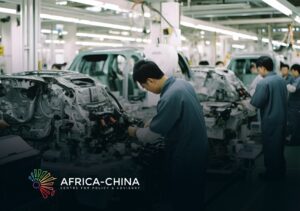
The world’s number one industrial powerhouse, China, has recently been stretched to respond to claims of overcapacity by the United States and European allies.
It is now a known fact that China is leading the rest of the world in a number of sectors, demonstrating the success of its efforts and investments in cutting-edge technologies. Strategic industries such as chemicals, basic metals, computers and electronics, and automobiles—more especially, new energy vehicles—are seeing a sharp increase in the market share of Chinese firms.
For many years, there have been discussions concerning China’s overcapacity issue. Lately, a number of industries, including those that deal with cement, steel, solar panels, and wind turbines, have begun to discuss the matter.
The conversation was rekindled in the wake of US Treasury Secretary Janet Yellen’s April visit to China, during which she raised concerns about industrial overcapacity and stated that China’s economy was too big to “export its way to rapid growth.” She also advocated for a return to market-oriented reforms and a move away from state-driven investment.
Before moving forward, we must pose a straightforward question to ourselves, with a data-supported answer. Based on current data, is there an overcapacity in China in any of the key sectors, especially the green economy? The answer is NO!.
No single piece of data proves that there’s a problem of overcapacity in China. So why the insistence by the West that there is?
Overcapacity explained, a problem?
It’s helpful to make the topic of discussion clear; for example, when someone talks about overcapacity, what precisely are they talking about?
Overcapacity is simply defined as the ‘excessive capacity for production or services in relation to demand’. The circumstance where a factory or industry is unable to sell as much as its capacity allows it to produce.
The problem associated with the term overcapacity, which has raised the debate, occurs when a nation’s excess capacity starts to drive away foreign competition and hinder the growth of other nations’ industries.
This definition is the guide to judging whether, indeed, China’s current production capacity in the green economy, more especially, should ignite a concern and raise a debate about overcapacity.
Is it a case of reality fuelled by genuine concerns or excessive anxiety in the developed world?
Overcapacity argument is flawed
Borrowing the words of George Yeo, Singapore’s former Foreign Minister, Western countries enjoy everything but accuse China of “working too hard” and “overcapacity.” He further opined that the accusation of China’s overcapacity is an excuse for laziness.
Are you familiar with the term comparative advantage? Let me refresh your memory: it is the situation where an economy has the ability to produce a particular good or service at a lower opportunity cost than its trading partners. It implies that nations will interact through trade, exporting the items in which they are comparatively stronger.
According to the free market principle, manufacturing and exporting more than is needed domestically is perfectly acceptable, and nations that have a competitive advantage in a given field should invest in it. Overcapacity beyond domestic demand is not an issue as long as production does not surpass demand globally.
Li Dawei, director of the Emerging Economies Research Office of the Institute of Foreign Economic Studies of the China Academy of Macroeconomic Research, said that calling exports of excess products “overcapacity” is a denial of the global division of labor theory put forth by Adam Smith and David Ricardo several centuries ago.
In this case, we ask a simple question: Is the global demand for EVs lower than the supply? The answer is a big no. All countries in the global south are currently enacting new auto-policies to tackle their climate-related commitments. They strongly encourage the use of EVs as the standard of transportation. Therefore, there’s a huge gap in terms of demand over the next few decades.
China is criticized for unfair competition, and this is utterly unjustified. In the case of China, economies of scale, innovation, and full supply chain integration account for its competitive advantages in the NEV sector rather than subsidies. Currently, it appears that there are no formal NEV industry subsidies in place, with the exception of a purchase tax waiver for NEVs, which has also been adopted by other countries.
China’s EV Capacity & Global Green Goals
According to a 2020 Information Technology and Innovation Foundation (ITIF) report, China was the world’s top producer in seven out of the ten industries examined. In terms of production, China ranked first in the world for computers and electronics, chemicals, machinery and equipment, automobiles, manufactured and basic metals, and electrical equipment.
The EV market is growing quickly on a global scale. For instance, 13.6 million EVs were sold globally in 2023. Global EV demand is expected to expand six times between 2021 and 2030, according to McKinsey, with global sales expected to increase by 25–30 percent this year.
Since electric vehicles (EVs) run on rechargeable batteries, it is possible to cut pollutants in contrast to traditional vehicles. Battery electric vehicles (BEVs) run entirely on electricity and don’t emit any tailpipe pollutants.
Evidently, China leads the world in both EV sales and production. It exported 1.2 million EVs last year in addition to producing and selling the most EVs (9.58 million and 9.49 million units, respectively). Additionally, 11.5 million EVs should be produced and 5.5 million exported in 2024.
China has made significant investments in the development of EV technology, and its technological innovations and legislation have greatly aided its success in the global EV industry.
The country has made significant strides in the field of battery technology, which has changed the game. It should be highlighted that, rather than being overcapacity, China’s exports of EVs have been rising quickly because of their high quality and performance.
We strongly argue that effort should be expended on how to make the green transition work for the world to develop sustainably. Fighting over who will gain from the green transition should be less of an emphasis than guiding the globe toward a more sustainable course.
Conclusion:
The European Automobile Manufacturers’ Association (ACEA) reports that worldwide car production eventually exceeded pre-pandemic levels in 2023. China’s auto industry has expanded by about 22% over the past five years, and its market share has risen from 28% to 33.5%.
The International Energy Agency projects that by 2030, there may be 45 million NEVs on the road worldwide. Even with a 20 percent annual growth rate in production, China is only expected to generate about 34 million NEVs by 2030—well short of the world’s need.
Overall, the evidence does not support the notion that China is driving out global production, even though China has achieved pretty considerable increases in market share.
The average levelized cost of energy for wind power and solar power generation plants worldwide has decreased by more than 60% and 80%, respectively, during the last ten years, according to a report from the International Renewable Energy Agency. The creativity, manufacturing, and engineering of China are largely responsible for this.
China’s $890 billion investment in clean-energy sectors is almost as large as total global investments in fossil fuel supply in 2023 and similar to the GDP of Switzerland or Turkey. This investment philosophy is contributing to sustainable global growth.
Reaching climate targets has beneficial externalities that go far beyond gaining market share in the green economy. This is what China is showing the world, and lessons need to be learned from them instead of antagonizing them.
About author
Paul is the Executive Director, Africa-China Centre for Policy & Advisory.
ACCPA is Sino-African research and policy think tank in Ghana, with teams in Morocco, Tanzania, Tunisia, the DRC, China, the UK, Ethiopia, and Botswana.
www.africachinacentre.org | [email protected]










